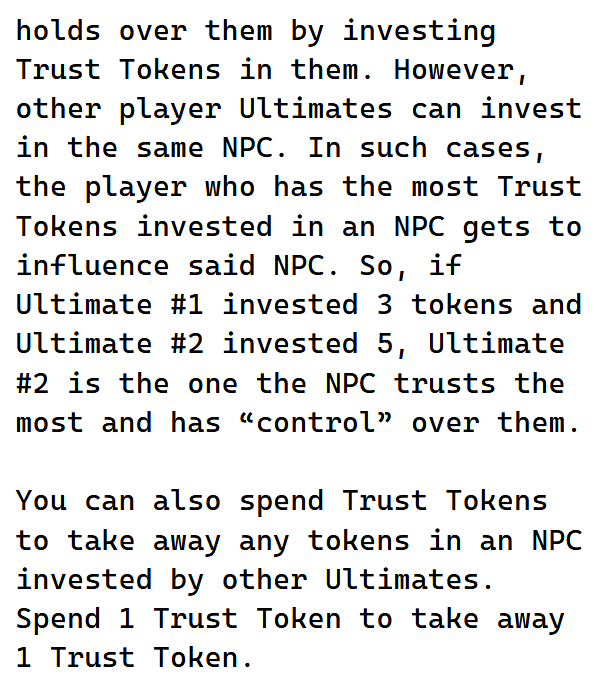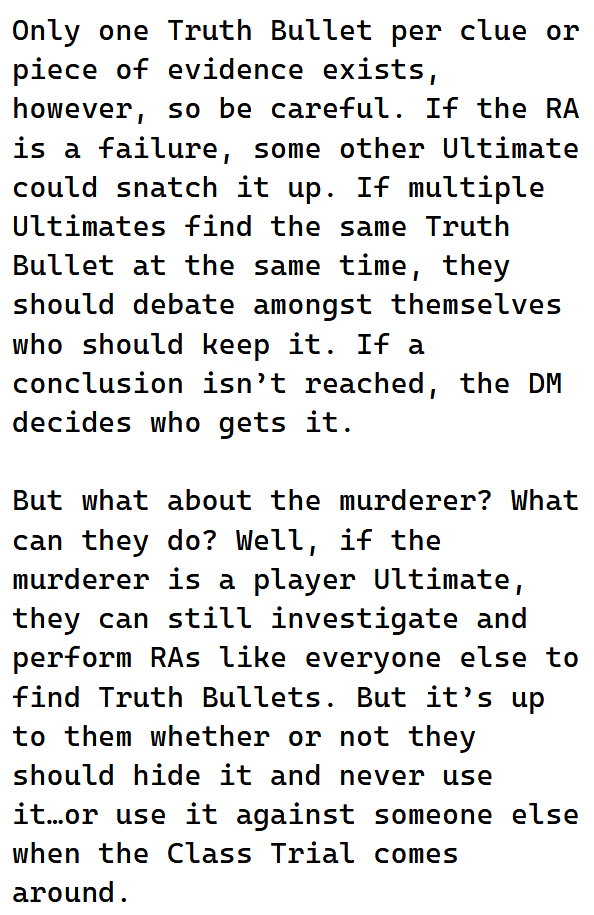Zetsubou Trigger
Solo Project | Social deduction tabletop role-playing game based on Danganronpa | Notepad, Microsoft Word | Created a custom “engine” for conflict resolution to emulate the series’ gun iconography
Zetsubou Trigger is a social deduction tabletop roleplaying game based on the Danganronpa series of games. It’s about a group of prodigies known as “Ultimates” that are trapped in a killing game and forced to murder one another. When a murder occurs, the Ultimates must investigate the crime scene and debate one another in Class Trials in order to vote the murderer out.
This game is a weird case when it comes to being a fangame. I like some of the concepts and characters, but I’m not exactly a fan in the typical sense. There are some aspects of the series that I’m uncomfortable with, but I don’t hate it. It was a very “make this game for this IP like being you’re commissioned by its owner company to do it” type of thing. But even then, I was still somewhat inspired to make it into a fully-fledged tabletop game. However, there are some challenges with translating a stylish investigative game into dice and numbers, especially said stylish aesthetic.
Gunning for Spinners
One of the most notable aspects of the Danganronpa franchise is its usage of gun iconography to depict arguments and counterarguments. Of course, there are other weapons involved like swords and missiles, but gun and bullets are the most important. It’s so important that, besides being a part of the in-game user interface, it’s literally part of the title; it being a combination of the Japanese words for “bullet” (dangan/弾丸) and “refute” (ronpa/論破), and an aiming reticle being incorporated into the logo.
This is why I felt like it was important that I included that iconography somewhere within the game. My immediate solution to this was to use a six-sided spinner.
The idea behind the spinner is to make it like players are using a revolver pistol, like they’re playing (an extremely safe and non-lethal version of) Russian Roulette. They choose which slots on the spinner count as successes for whatever action they’re attempting to make, inserting “bullets” into a “chamber.” Granted, it is a little weird that shooting yourself with a bullet is considered a “success” in the grand scheme of things, but whatever.
Of course, not everyone is going to have a six-sided spinner. So, the game allows players to use a six-sided die instead, choosing which numbers rolled count as successes. And to add to the “Russian Roulette” aspect of the game, players can choose to “aim” at another to have any and all consequences affect the other rather than themselves.
It’s not an outright malicious action. There might be times where someone could be a wingman for another player to help them without needing the other to roll.
There are other gun elements involved in the game, such as evidence and clues being called “Truth Bullets” and using them to “shoot down” arguments by refuting or agreeing with certain statements said during the Trial phase of the game. But besides that, the most important part in incorporating the gun iconography is to add it to the mechanics themselves, and that’s why “rolling” is the same as spinning the chamber of a revolver.
One of the most interesting aspects about Danganronpa as a series, I feel, is what it was before it became Danganronpa. And that “it” was something known as DISTRUST.
DISTRUST is a murder mystery visual novel about teenagers killing and arguing with each other in a desperate struggle to survive. It was a game that was planned to have branching paths depending on which students you choose to side with. Unfortunately, due to technological limitations at the time, as well as the gruesome nature of it, it was cancelled, scrapped, and reworked into Danganronpa.
Not much information about DISTRUST can be found. Most of what is known and available to the public is concentrated in a few Wikipedia pages, whether official or fanmade. But there’s something fascinating about a thing’s early days, of what it was during gestation when people where just shooting ideas or throwing things against a wall to see what stuck. One of those interesting ideas was the game’s “Trust Meter.” As the game would’ve gone along, your fellow classmates would grow to trust or distrust you, affecting what murders would occur in which of the branching paths you would’ve been currently in.
There’s something about this system that captivated me, something about it that made me add it to the game.
TRUSTing the Process
This is where the token economy comes in. To simulate players forming alliances in NPCs and sowing trust or distrust in themselves and others, they can “invest” Trust Tokens in an NPC. The way it works is that the player with the most tokens invested in an NPC is the one who “controls” that NPC. This will let the gamemaster know to influence their behavior towards the character and be more willing to do things for them. But the most useful aspect of this mechanic is the aspect of extra votes. Before a trial ends, players will have to vote on who they believe the murderer is. Each player gets one vote, excluding NPCs. However, if an NPC trusts one player the most, that player can vote an additional time.
Danganronpa, at its core, is a murder mystery. Murder mysteries are… Well, mysterious. They keep you on your toes, they keep you constantly guessing, but they give you clues and puzzle pieces that can let the audience participate in the mystery itself, letting them be their own detective if they’d like. Danganronpa’s mysteries are unpredictable, both in terms of how the murder is committed and who is involved. Anyone could die. Anyone could be a murderer. Anytime, any place.
Having this be a thing without the game master outright railroading the story can be difficult. An NPC being the murder and/or victim is simple. At that point, everyone is just playing Danganronpa in a tabletop setting. But what if either one is a player?
There are so many things to consider with a game like this: What if a player dies by random chance despite not wanting to? What if a murder goes completely sideways and the murderer becomes the victim? What if a player wants to be the murderer themselves? And even if you could answer these questions, the next problem you’d have to deal with is setting the crime scene and generating the clues and making the trial that comes after… Even coming up with a good motive besides “If you get away with murder, you win the game” can be hard.
A lot to consider.
On Murder Mysteries,
Unpredictability, & Player Agency
Zetsubou Trigger focuses on giving players agency when it comes to committing murder. Of course, the game master usually decides at random who gets to murder someone and/or who’s the victim, but they should ask the players first if they’re ever involved. If everyone agrees, then the game becomes a private session where someone dies no matter what. Gameplay proceeds as normal with players rolling for skill checks until someone dies. Once the murder is complete and at least three characters find the body of the deceased, the investigation begins. But there is always the potential of something going wrong, which is why the target of murder is capable of defending themselves and surviving the encounter. However, even if they do survive, the game will consider them as the “murderer.” This is intentional, as it calls back to the very first mystery of the first Danganronpa game: a murder goes wrong, the target kills the murderer in self-defense, but the target is the murderer that must be found out in order to survive.
But once the investigation begins, what should the murderer do in the meantime without giving it away? Naturally, players will want to try and sabotage the investigation without revealing who they are. It’s for that reason that I’ve created the “Truth Bullets,” evidence pieces that players gather during the investigation phase. Anyone can pick up a Truth Bullet, but only one exists per each piece of evidence, so it’s first come, first served.
Then there’s the trial phase of the game, starting when there are no more Truth Bullets to find. Here, the mystery is solved through debate, where the game master controls the NPCs into saying contradictory statements for players to use their Truth Bullets on. If used, the game master will tell the players whether their use was correct or incorrect.
This gives the murderer a bit more agency instead of waiting around to either get caught or not. The murderer can pick up a Truth Bullet and simply never use it during the trial phase. Alternatively, they can use it during a trial to try and throw others off their trail, because the game master will always say that the murderer’s usage of the Truth Bullet is correct, no matter what. The player-controlled murderer remains active during gameplay, it doesn’t end at murder.















